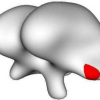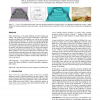40 search results - page 6 / 8 » Folding and Unfolding in Computational Geometry |
ICCV
2003
IEEE
14 years 9 months ago
2003
IEEE
In this paper, we overcome a major drawback of the level set framework: the lack of point correspondences. We maintain explicit backward correspondences from the evolving interfac...
SIGGRAPH
2010
ACM
13 years 11 months ago
2010
ACM
Paper architectures are 3D paper buildings created by folding and cutting. The creation process of paper architecture is often laborintensive and highly skill-demanding, even with...
PUK
2003
13 years 8 months ago
2003
This paper exploits the spatial representation of state space problem graphs to preprocess and enhance heuristic search engines. It combines classical AI exploration with computati...
CSB
2004
IEEE
13 years 11 months ago
2004
IEEE
Motivation: Since the whole genome sequences for many species are currently available, computational predictions of RNA secondary structures and computational identifications of t...
CSB
2003
IEEE
14 years 19 days ago
2003
IEEE
Recognition of a protein’s fold provides valuable information about its function. While many sequence-based homology prediction methods exist, an important challenge remains: tw...


